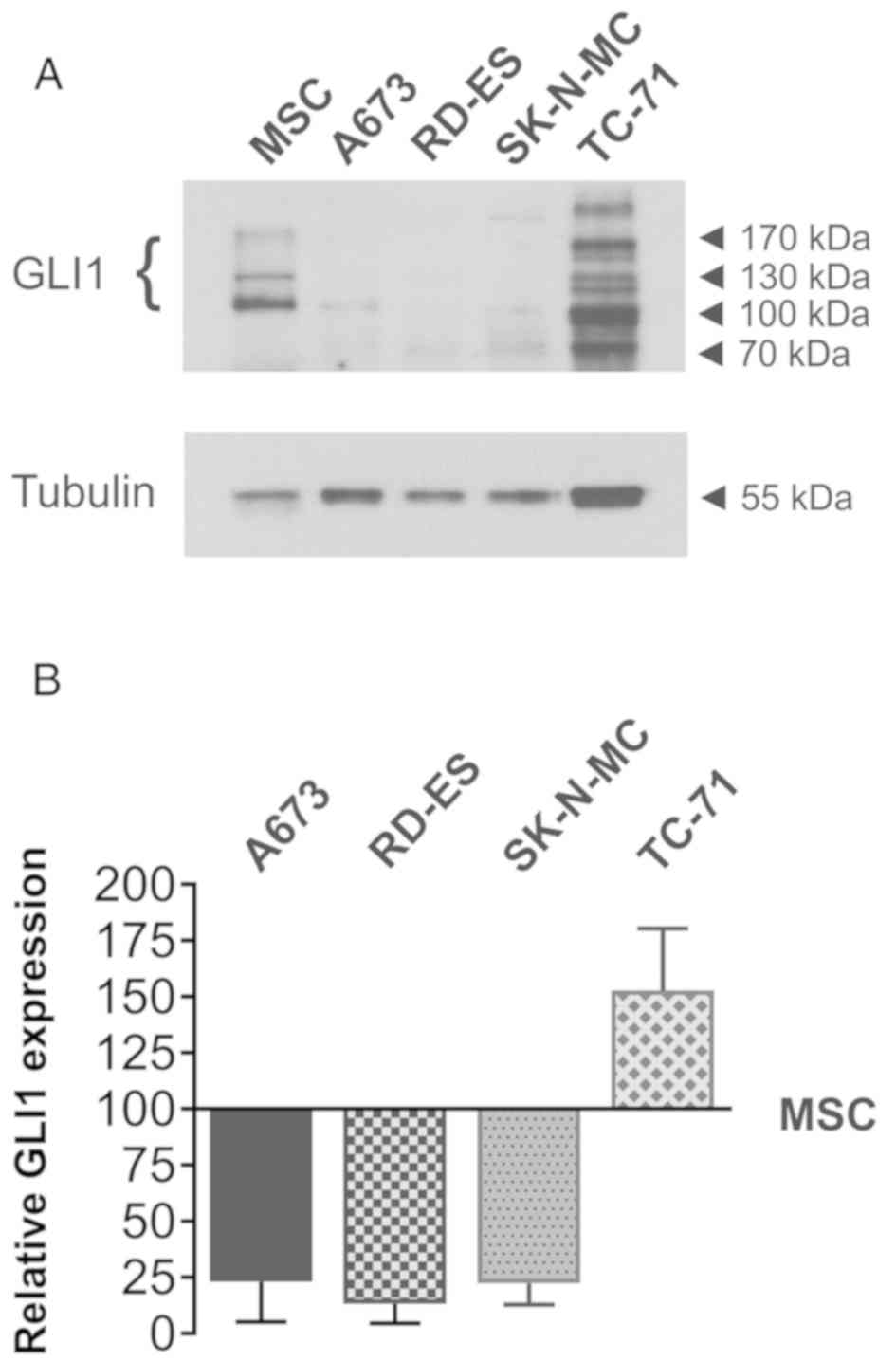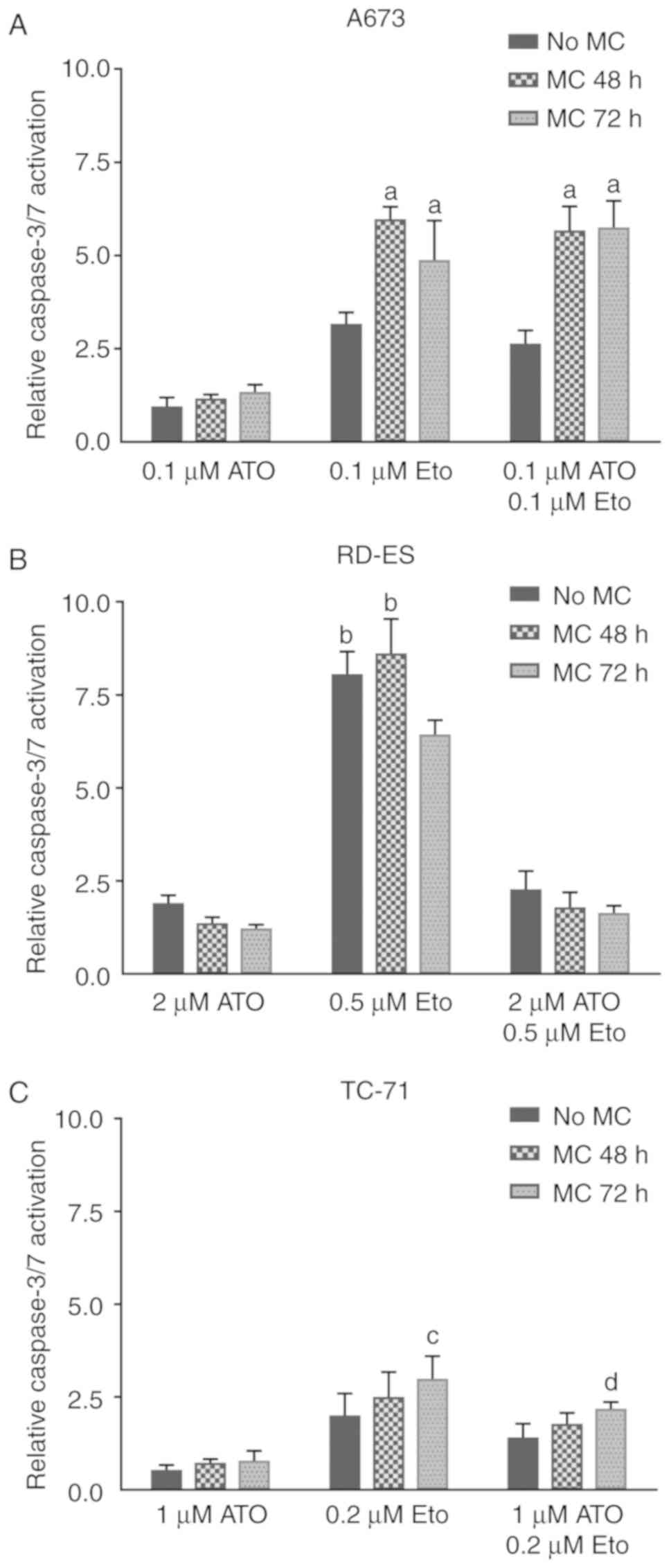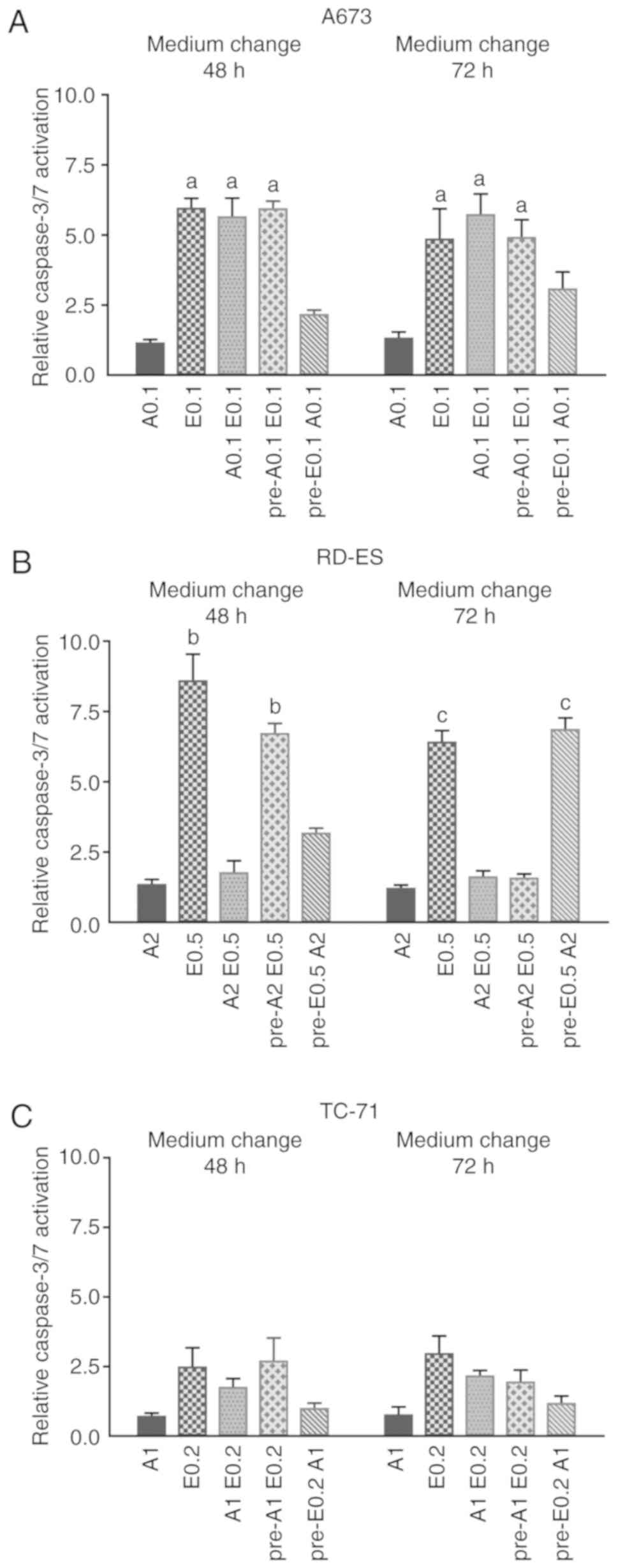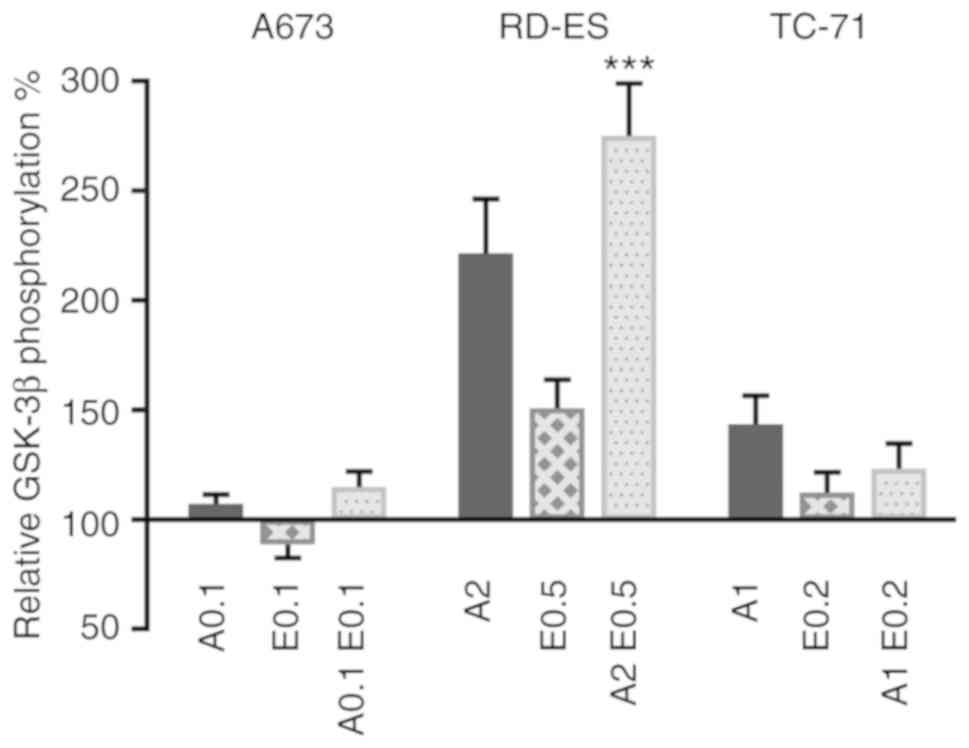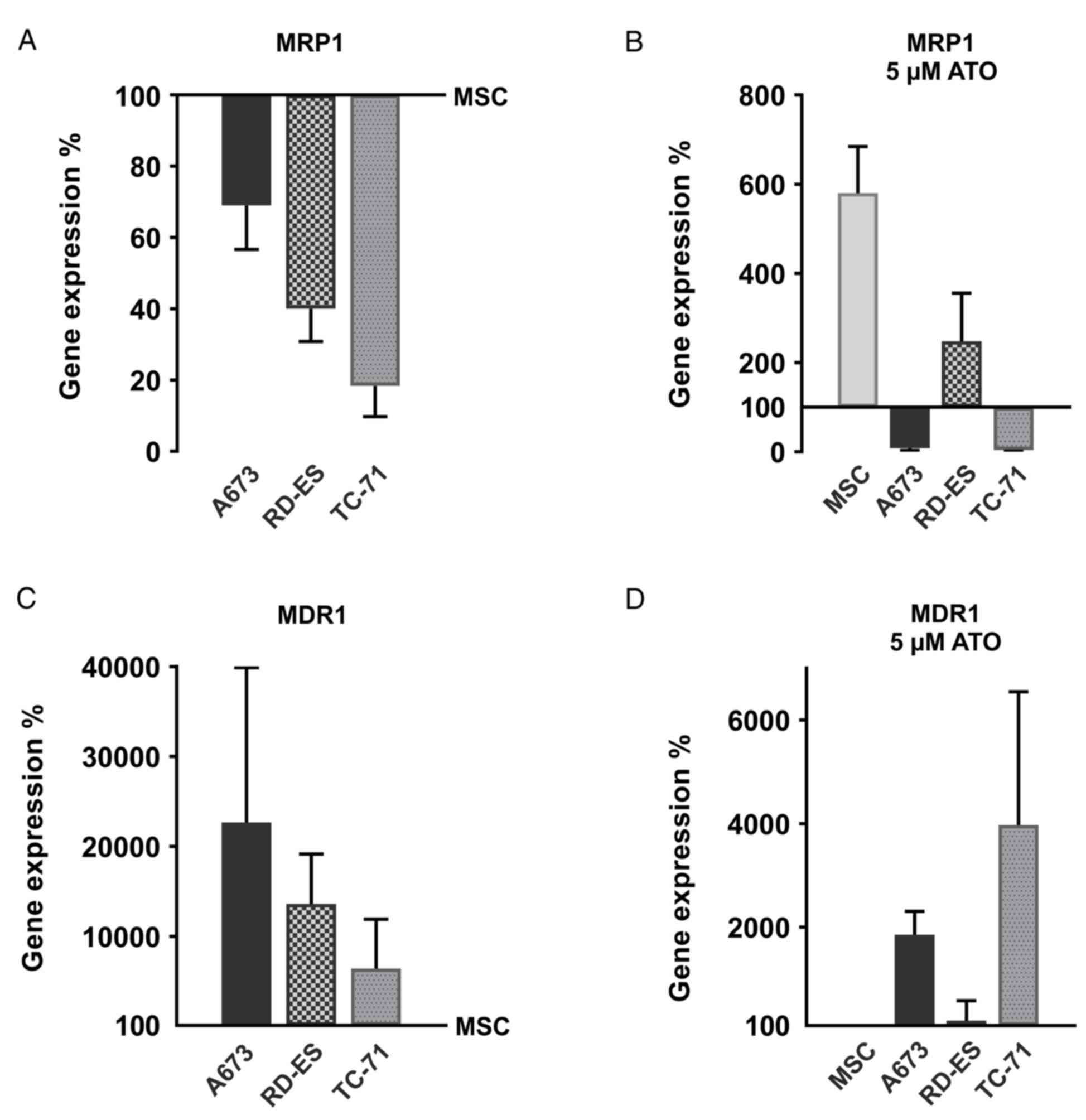|
1
|
Ross KA, Smyth NA, Murawski CD and Kennedy
JG: The biology of Ewing sarcoma. ISRN Oncol.
2013:7597252013.PubMed/NCBI
|
|
2
|
Tirode F, Laud-Duval K, Prieur A, Delorme
B, Charbord P and Delattre O: Mesenchymal stem cell features of
Ewing tumors. Cancer Cell. 11:421–429. 2007. View Article : Google Scholar : PubMed/NCBI
|
|
3
|
Beauchamp E, Bulut G, Abaan O, Chen K,
Merchant A, Matsui W, Endo Y, Rubin JS, Toretsky J and Uren A: GLI1
is a direct transcriptional target of EWS-FLI1 oncoprotein. J Biol
Chem. 284:9074–9082. 2009. View Article : Google Scholar : PubMed/NCBI
|
|
4
|
Franzetti GA, Laud-Duval K, van der Ent W,
Brisac A, Irondelle M, Aubert S, Dirksen U, Bouvier C, de Pinieux
G, Snaar-Jagalska E, et al: Cell-to-cell heterogeneity of
EWSR1-FLI1 activity determines proliferation/migration choices in
Ewing sarcoma cells. Oncogene. 36:3505–3514. 2017. View Article : Google Scholar : PubMed/NCBI
|
|
5
|
Boehme KA, Nitsch J, Riester R,
Handgretinger R, Schleicher SB, Kluba T and Traub F: Arsenic
trioxide potentiates the effectiveness of etoposide in Ewing
sarcomas. Int J Oncol. 49:2135–2146. 2016. View Article : Google Scholar : PubMed/NCBI
|
|
6
|
Beauchamp EM, Ringer L, Bulut G, Sajwan
KP, Hall MD, Lee YC, Peaceman D, Ozdemirli M, Rodriguez O,
Macdonald TJ, et al: Arsenic trioxide inhibits human cancer cell
growth and tumor development in mice by blocking hedgehog/GLI
pathway. J Clin Invest. 121:148–160. 2011. View Article : Google Scholar : PubMed/NCBI
|
|
7
|
Sand LG, Szuhai K and Hogendoorn PC:
Sequencing overview of Ewing sarcoma: A journey across genomic,
epigenomic and transcriptomic landscapes. Int J Mol Sci.
16:16176–16215. 2015. View Article : Google Scholar : PubMed/NCBI
|
|
8
|
May WA, Grigoryan RS, Keshelava N, Cabral
DJ, Christensen LL, Jenabi J, Ji L, Triche TJ, Lawlor ER and
Reynolds CP: Characterization and drug resistance patterns of
Ewing's sarcoma family tumor cell lines. PLoS One. 8:e800602013.
View Article : Google Scholar : PubMed/NCBI
|
|
9
|
Oda Y, Dockhorn-Dworniczak B, Jürgens H
and Roessner A: Expression of multidrug resistance-associated
protein gene in Ewing's sarcoma and malignant peripheral
neuroectodermal tumor of bone. J Cancer Res Clin Oncol.
123:237–239. 1997. View Article : Google Scholar : PubMed/NCBI
|
|
10
|
Roundhill EA and Burchill SA: Detection
and characterisation of multi-drug resistance protein 1 (MRP-1) in
human mitochondria. Br J Cancer. 106:1224–1233. 2012. View Article : Google Scholar : PubMed/NCBI
|
|
11
|
Roessner A, Ueda Y, Bockhorn-Dworniczak B,
Blasius S, Peters A, Wuisman P, Ritter J, Paulussen M, Jürgens H
and Böcker W: Prognostic implication of immunodetection of P
glycoprotein in Ewing's sarcoma. J Cancer Res Clin Oncol.
119:185–189. 1993. View Article : Google Scholar : PubMed/NCBI
|
|
12
|
Mauz-Körholz C, Kachel M, Harms-Schirra B,
Klein-Vehne A, Tunn PU and Körholz D: Drug-induced caspase-3
activation in a Ewing tumor cell line and primary Ewing tumor
cells. Anticancer Res. 24:145–149. 2004.PubMed/NCBI
|
|
13
|
Casali PG, Bielack S, Abecassis N, Aro HT,
Bauer S, Biagini R, Bonvalot S, Boukovinas I, Bovee JVMG, Brennan
B, et al: ESMO Guidelines Committee, paedcan and ERN EURACAN: Bone
sarcomas: ESMO-PaedCan-EURACAN clinical practice guidelines for
diagnosis, treatment and follow-up. Ann Oncol. 29 (Suppl
4):iv79–iv95. 2018. View Article : Google Scholar : PubMed/NCBI
|
|
14
|
Clifford B, Beljin M, Stark GR and Taylor
WR: G2 arrest in response to topoisomerase II inhibitors: The role
of p53. Cancer Res. 63:4074–4081. 2003.PubMed/NCBI
|
|
15
|
Lin CF, Tsai CC, Huang WC, Wang YC, Tseng
PC, Tsai TT and Chen CL: Glycogen synthase kinase-3β and caspase-2
mediate ceramide- and etoposide-induced apoptosis by regulating the
lysosomal-mitochondrial axis. PLoS One. 11:e01454602016. View Article : Google Scholar : PubMed/NCBI
|
|
16
|
Lee KI, Su CC, Yang CY, Hung DZ, Lin CT,
Lu TH, Liu SH and Huang CF: Etoposide induces pancreatic β-cells
cytotoxicity via the JNK/ERK/GSK-3 signaling-mediated
mitochondria-dependent apoptosis pathway. Toxicol In Vitro.
36:142–152. 2016. View Article : Google Scholar : PubMed/NCBI
|
|
17
|
Ngok-Ngam P, Watcharasit P, Thiantanawat A
and Satayavivad J: Pharmacological inhibition of GSK3 attenuates
DNA damage-induced apoptosis via reduction of p53 mitochondrial
translocation and Bax oligomerization in neuroblastoma SH-SY5Y
cells. Cell Mol Biol Lett. 18:58–74. 2013. View Article : Google Scholar : PubMed/NCBI
|
|
18
|
Lengfelder E, Hofmann WK and Nowak D:
Impact of arsenic trioxide in the treatment of acute promyelocytic
leukemia. Leukemia. 26:433–442. 2012. View Article : Google Scholar : PubMed/NCBI
|
|
19
|
Boehme KA, Zaborski JJ, Riester R,
Schweiss SK, Hopp U, Traub F, Kluba T, Handgretinger R and
Schleicher SB: Targeting hedgehog signalling by arsenic trioxide
reduces cell growth and induces apoptosis in rhabdomyosarcoma. Int
J Oncol. 48:801–812. 2016. View Article : Google Scholar : PubMed/NCBI
|
|
20
|
Au WY, Tam S, Fong BM and Kwong YL:
Determinants of cerebrospinal fluid arsenic concentration in
patients with acute promyelocytic leukemia on oral arsenic trioxide
therapy. Blood. 112:3587–3590. 2008. View Article : Google Scholar : PubMed/NCBI
|
|
21
|
Kang YH, Yi MJ, Kim MJ, Park MT, Bae S,
Kang CM, Cho CK, Park IC, Park MJ, Rhee CH, et al:
Caspase-independent cell death by arsenic trioxide in human
cervical cancer cells: Reactive oxygen species-mediated
poly(ADP-ribose) polymerase-1 activation signals apoptosis-inducing
factor release from mitochondria. Cancer Res. 64:8960–8967. 2004.
View Article : Google Scholar : PubMed/NCBI
|
|
22
|
Beauchamp EM and Uren A: A new era for an
ancient drug: Arsenic trioxide and Hedgehog signaling. Vitam Horm.
88:333–354. 2012. View Article : Google Scholar : PubMed/NCBI
|
|
23
|
Dawood M, Hamdoun S and Efferth T:
Multifactorial modes of action of arsenic trioxide in cancer cells
as analyzed by classical and network pharmacology. Front Pharmacol.
9:1432018. View Article : Google Scholar : PubMed/NCBI
|
|
24
|
Chiu HW, Tseng YC, Hsu YH, Lin YF, Foo NP,
Guo HR and Wang YJ: Arsenic trioxide induces programmed cell death
through stimulation of ER stress and inhibition of the
ubiquitin-proteasome system in human sarcoma cells. Cancer Lett.
356:762–772. 2015. View Article : Google Scholar : PubMed/NCBI
|
|
25
|
Kozono S, Lin YM, Seo HS, Pinch B, Lian X,
Qiu C, Herbert MK, Chen CH, Tan L, Gao ZJ, et al: Arsenic targets
Pin1 and cooperates with retinoic acid to inhibit cancer-driving
pathways and tumor-initiating cells. Nat Commun. 9:30692018.
View Article : Google Scholar : PubMed/NCBI
|
|
26
|
Jiang L, Wang L, Chen L, Cai GH, Ren QY,
Chen JZ, Shi HJ and Xie YH: As2O3 induces apoptosis in human
hepatocellular carcinoma HepG2 cells through a ROS-mediated
mitochondrial pathway and activation of caspases. Int J Clin Exp
Med. 8:2190–2196. 2015.PubMed/NCBI
|
|
27
|
Yen YP, Tsai KS, Chen YW, Huang CF, Yang
RS and Liu SH: Arsenic induces apoptosis in myoblasts through a
reactive oxygen species-induced endoplasmic reticulum stress and
mitochondrial dysfunction pathway. Arch Toxicol. 86:923–933. 2012.
View Article : Google Scholar : PubMed/NCBI
|
|
28
|
Kumar S, Yedjou CG and Tchounwou PB:
Arsenic trioxide induces oxidative stress, DNA damage, and
mitochondrial pathway of apoptosis in human leukemia (HL-60) cells.
J Exp Clin Cancer Res. 33:422014. View Article : Google Scholar : PubMed/NCBI
|
|
29
|
States JC: Disruption of mitotic
progression by arsenic. Biol Trace Elem Res. 166:34–40. 2015.
View Article : Google Scholar : PubMed/NCBI
|
|
30
|
Huang HS, Liu ZM and Cheng YL: Involvement
of glycogen synthase kinase-3β in arsenic trioxide-induced p21
expression. Toxicol Sci. 121:101–109. 2011. View Article : Google Scholar : PubMed/NCBI
|
|
31
|
Schleicher SB, Zaborski JJ, Riester R,
Zenkner N, Handgretinger R, Kluba T, Traub F and Boehme KA:
Combined application of arsenic trioxide and lithium chloride
augments viability reduction and apoptosis induction in human
rhabdomyosarcoma cell lines. PLoS One. 12:e01788572017. View Article : Google Scholar : PubMed/NCBI
|
|
32
|
Beurel E and Jope RS: The paradoxical pro-
and anti-apoptotic actions of GSK3 in the intrinsic and extrinsic
apoptosis signaling pathways. Prog Neurobiol. 79:173–189. 2006.
View Article : Google Scholar : PubMed/NCBI
|
|
33
|
Battula VL, Treml S, Bareiss PM, Gieseke
F, Roelofs H, de Zwart P, Müller I, Schewe B, Skutella T, Fibbe WE,
et al: Isolation of functionally distinct mesenchymal stem cell
subsets using antibodies against CD56, CD271, and mesenchymal stem
cell antigen-1. Haematologica. 94:173–184. 2009. View Article : Google Scholar : PubMed/NCBI
|
|
34
|
Livak KJ and Schmittgen TD: Analysis of
relative gene expression data using real-time quantitative PCR and
the 2(-Delta Delta C(T)) method. Methods. 25:402–408. 2001.
View Article : Google Scholar : PubMed/NCBI
|
|
35
|
Laurendeau I, Ferrer M, Garrido D, D'Haene
N, Ciavarelli P, Basso A, Vidaud M, Bieche I, Salmon I and Szijan
I: Gene expression profiling of the hedgehog signaling pathway in
human meningiomas. Mol Med. 16:262–270. 2010. View Article : Google Scholar : PubMed/NCBI
|
|
36
|
Xie J, Li DW, Chen XW, Wang F and Dong P:
Expression and significance of hypoxia-inducible factor-1α and
MDR1/P- glycoprotein in laryngeal carcinoma tissue and hypoxic
Hep-2 cells. Oncol Lett. 6:232–238. 2013. View Article : Google Scholar : PubMed/NCBI
|
|
37
|
König J, Hartel M, Nies AT, Martignoni ME,
Guo J, Büchler MW, Friess H and Keppler D: Expression and
localization of human multidrug resistance protein (ABCC) family
members in pancreatic carcinoma. Int J Cancer. 115:359–367. 2005.
View Article : Google Scholar : PubMed/NCBI
|
|
38
|
Benaitreau D, Dieudonné MN, Dos Santos E,
Leneveu MC, Mazancourt PD and Pecquery R: Antiproliferative effects
of adiponectin on human trophoblastic cell lines JEG-3 and BeWo.
Biol Reprod. 80:1107–1114. 2009. View Article : Google Scholar : PubMed/NCBI
|
|
39
|
Amable L, Gavin E, Kudo K, Meng E, Rocconi
RP, Shevde LA and Reed E: GLI1 upregulates C-JUN through a specific
130-kDa isoform. Int J Oncol. 44:655–661. 2014. View Article : Google Scholar : PubMed/NCBI
|
|
40
|
McCubrey JA, Steelman LS, Bertrand FE,
Davis NM, Sokolosky M, Abrams SL, Montalto G, D'Assoro AB, Libra M,
Nicoletti F, et al: GSK-3 as potential target for therapeutic
intervention in cancer. Oncotarget. 5:2881–2911. 2014. View Article : Google Scholar : PubMed/NCBI
|
|
41
|
Gottesman MM: Mechanisms of cancer drug
resistance. Annu Rev Med. 53:615–627. 2002. View Article : Google Scholar : PubMed/NCBI
|
|
42
|
Kauer M, Ban J, Kofler R, Walker B, Davis
S, Meltzer P and Kovar H: A molecular function map of Ewing's
sarcoma. PLoS One. 4:e54152009. View Article : Google Scholar : PubMed/NCBI
|
|
43
|
Chaturvedi A, Hoffman LM, Jensen CC, Lin
YC, Grossmann AH, Randall RL, Lessnick SL, Welm AL and Beckerle MC:
Molecular dissection of the mechanism by which EWS/FLI expression
compromises actin cytoskeletal integrity and cell adhesion in Ewing
sarcoma. Mol Biol Cell. 25:2695–2709. 2014. View Article : Google Scholar : PubMed/NCBI
|
|
44
|
McCafferty-Grad J, Bahlis NJ, Krett N,
Aguilar TM, Reis I, Lee KP and Boise LH: Arsenic trioxide uses
caspase-dependent and caspase-independent death pathways in myeloma
cells. Mol Cancer Ther. 2:1155–1164. 2003.PubMed/NCBI
|
|
45
|
Scholz C, Wieder T, Stärck L, Essmann F,
Schulze-Osthoff K, Dörken B and Daniel PT: Arsenic trioxide
triggers a regulated form of caspase-independent necrotic cell
death via the mitochondrial death pathway. Oncogene. 24:1904–1913.
2005. View Article : Google Scholar : PubMed/NCBI
|
|
46
|
Raju GP: Arsenic: A potentially useful
poison for hedgehog-driven cancers. J Clin Invest. 121:14–16. 2011.
View Article : Google Scholar : PubMed/NCBI
|
|
47
|
Yang K, Chen Z, Gao J, Shi W, Li L, Jiang
S, Hu H, Liu Z, Xu D and Wu L: The Key roles of GSK-3β in
regulating mitochondrial activity. Cell Physiol Biochem.
44:1445–1459. 2017. View Article : Google Scholar : PubMed/NCBI
|
|
48
|
Shukalek CB, Swanlund DP, Rousseau RK,
Weigl KE, Marensi V, Cole SP and Leslie EM: Arsenic triglutathione
[As(GS)3] transport by multidrug resistance protein 1 (MRP1/ABCC1)
is selectively modified by phosphorylation of Tyr920/Ser921 and
glycosylation of Asn19/Asn23. Mol Pharmacol. 90:127–139. 2016.
View Article : Google Scholar : PubMed/NCBI
|
|
49
|
Maciaszczyk-Dziubinska E, Wawrzycka D and
Wysocki R: Arsenic and antimony transporters in eukaryotes. Int J
Mol Sci. 13:3527–3548. 2012. View Article : Google Scholar : PubMed/NCBI
|
|
50
|
Seo T, Urasaki Y and Ueda T: Establishment
of an arsenic trioxide-resistant human leukemia cell line that
shows multidrug resistance. Int J Hematol. 85:26–31. 2007.
View Article : Google Scholar : PubMed/NCBI
|
|
51
|
Santisteban M: ABC transporters as
molecular effectors of pancreatic oncogenic pathways: The
Hedgehog-GLI model. J Gastrointest Cancer. 41:153–158. 2010.
View Article : Google Scholar : PubMed/NCBI
|
|
52
|
Erdei Z, Lőrincz R, Szebényi K, Péntek A,
Varga N, Likó I, Várady G, Szakács G, Orbán TI, Sarkadi B and Apáti
A: Expression pattern of the human ABC transporters in pluripotent
embryonic stem cells and in their derivatives. Cytometry B Clin
Cytom. 86:299–310. 2014. View Article : Google Scholar : PubMed/NCBI
|
|
53
|
Brown HK, Schiavone K, Gouin F, Heymann MF
and Heymann D: Biology of bone sarcomas and new therapeutic
developments. Calcif Tissue Int. 102:174–195. 2018. View Article : Google Scholar : PubMed/NCBI
|
|
54
|
Yu H, Ge Y, Guo L and Huang L: Potential
approaches to the treatment of Ewing's sarcoma. Oncotarget.
8:5523–5539. 2017.PubMed/NCBI
|















